Pascale Petit's Blog, page 8
December 11, 2011
Chinese Water: Jinze village near Shanghai, 2011
 George Szirtes and Clarissa Upchurch on the water stage in 'The Big House', our mystery home for the night
George Szirtes and Clarissa Upchurch on the water stage in 'The Big House', our mystery home for the nightAlthough I've just spent two weeks based in Shanghai, what I'll blog about first is the watery village of Jinze. Jinze (pronounced Gin Zeu– with long tone descending to rhyme with French 'peu') is about 80 miles from Shanghai but calm, rural and built around meanders of a river or a canal. Where exactly it is is still a mystery, as it was a late night mystery tour arranged by our gentle Chinese poet friend Xiao Kaiyu, to fill in the blank in our very sketchy 'programme'. Even Yang Lian doesn't know where it is, nor google, so it remains a dream of water, rain and rainbow bridges without sides that can be slipped on and over. I spent most of the journey trying to pronounce the name.
We arrived at night, and I slept in a vast room with ensuite jacuzzi and power shower room and an ensuite loo with heated toilet seat that raised itself on approach. I woke at 5am and worked on my translations at the large trestle table before the windows, while waiting for dawn. When I opened the curtains I found I was next to a wide waterway swirling past my huge, wood-filigreed window. It had rained all night and the water seemed almost under the floor, and I wondered what happened during floods.
But it was a sunny day, so George Szirtes, Clarissa Upchurch and myself walked along the river/canal and over the numerous ancient arched bridges over it. At times the waterways forked. The complex we slept in was itself built between water, with water channels outside each door. We visited a Taoist temple and a Buddhist temple built around a 650 year old gingko tree strung with red lanterns. I think it was the first time I relaxed since I'd arrived in China, away from the cacophony of horns outside our Fudan University hotel.
After clambering over many bridges and ambling along narrow lanes of the village, and Yang Lian had lured George onto a dragon boat, we had lunch and were joined by Kaiyu, who whisked us away to what I thought was going to be a stroll in the vegetable gardens. And this is where the mystery tour became surreal, a Russian doll of surrealism was slowly opened behind the willow and bamboo paths. Hall after hall of exquisitely designed galleries were unlocked for us, their floorboards pastel shades of woods from the factories they had been reconstructed from. They contained antique furniture, craft objects, books, dolls, gourds, sedan chairs, wardrobes, puppets, emperors' beds, seals, and happiest of all – textiles. Heavily embossed silk robes for Buddhas, more 3D than embroidery. Locked in one endless hall were a mother and daughter of the Miao southwest China ethnic group, weaving their sumptuous cloth, silver in their hair. I'd come across them before on Qingcheng Mountain in Sichuan Province. Up more stairs to an attic where designer cloaks were being woven from silk organza and a raffia-like wool. Clarissa tried one on and it suited her perfectly.
We were led out onto terraces with views of the waterways and their bridges. Kaiyu pointed to a room where he comes to write and we were invited to return for a writing retreat, an invitation I almost took up, before I remembered how far it was from home, this land of water like woven silk, of silk like woven water, yellow gingko leaves strewn on the ground like confetti.
So back to the endless fifty-floor towers of Shanghai, via a visit to one of the founders of the Jinze Craft Museum, the quiet ex-artist Mr Hu, his champagne coloured poodles and talk of his friendship with Prince Charles and the royalty who have visited the Mystery for architectural design tips, before a dash for the rush-hour subway where we swayed with our luggage for hours before ascending at the Centre for the Oriental Arts, to another gift from Kaiyu – a concert by the fusian group Amrita, almost all women, and their spellbinding music. In my first row seat I waited and waited to hear the Erhu, a kind of two stringed fiddle, as it features in a poem of Kaiyu's I was translating, a powerful poem about his mother's ghost. I was not disappointed. It sounded hoarse, primeval and sad, and I can still hear it like the sound of water that has dried up.
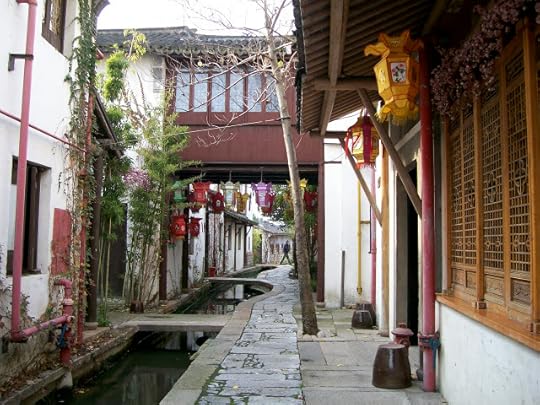 Entrance to my bedroom was over a little bridge over the water channel
Entrance to my bedroom was over a little bridge over the water channel George Szirtes, Clarissa Upchurch and myself, outside the breakfast room of 'The Big House'
George Szirtes, Clarissa Upchurch and myself, outside the breakfast room of 'The Big House' The slippery sideless bridge!
The slippery sideless bridge! A shrine to a village elder in the Taoist temple
A shrine to a village elder in the Taoist temple

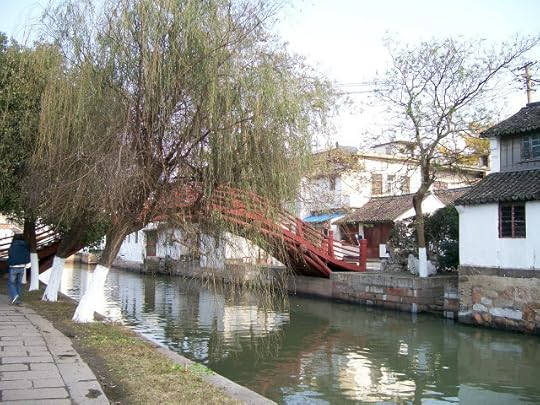
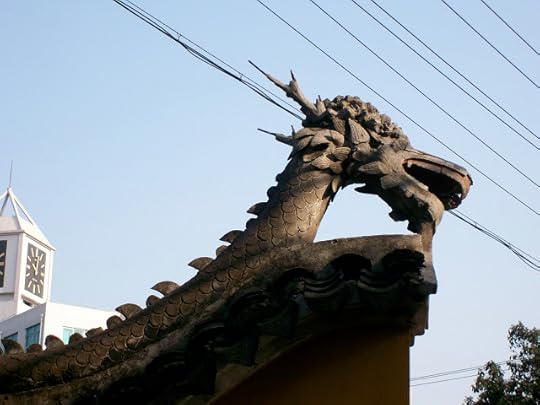 My favourite dragon
My favourite dragon
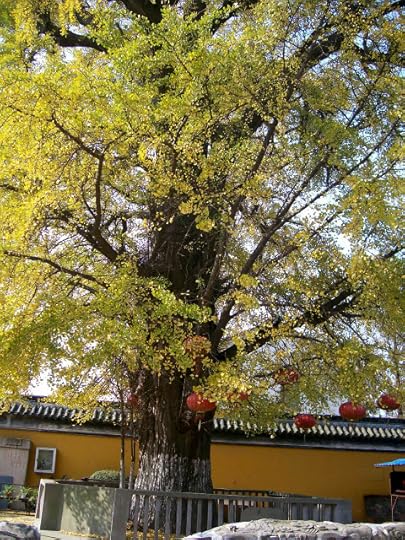 650 year old gingko tree in Buddhist temple courtyard
650 year old gingko tree in Buddhist temple courtyard cloud motif around dragon enclosure, gingko leaves inside
cloud motif around dragon enclosure, gingko leaves inside
 Yang Lian and George in the 'dragon' boat steered by a woman
Yang Lian and George in the 'dragon' boat steered by a woman Clarissa in the bridal sedan chair
Clarissa in the bridal sedan chair Hidden meanings in Chinese children's clothing and accessories etc
Hidden meanings in Chinese children's clothing and accessories etc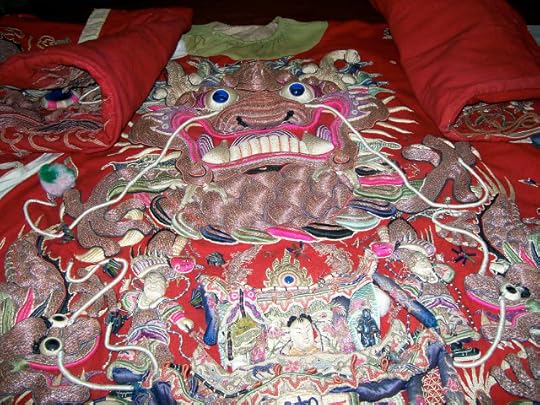 3D embossed monster on Buddha cloak in museum
3D embossed monster on Buddha cloak in museum Miao mother and daughter weavers locked in museum hall
Miao mother and daughter weavers locked in museum hall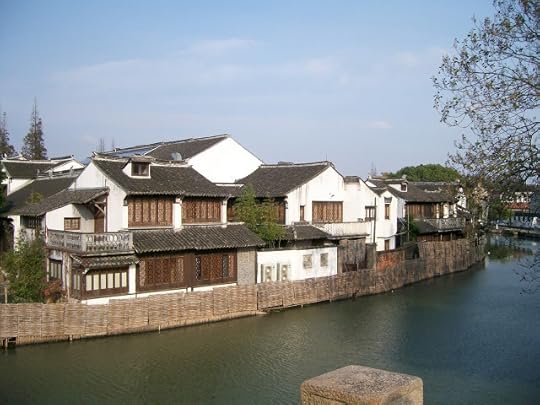 The two large wood filigree windows on ground floor were where I slept, the jacuzzi bathroom at the end on the left.
The two large wood filigree windows on ground floor were where I slept, the jacuzzi bathroom at the end on the left.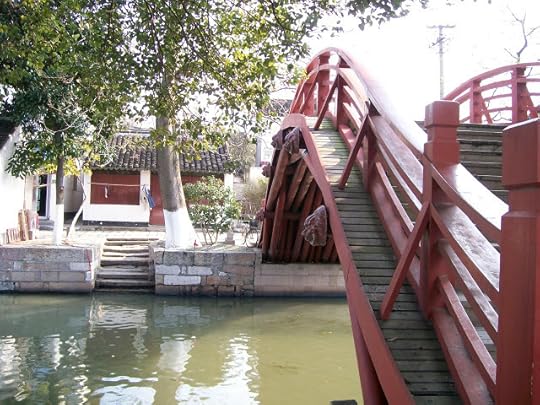
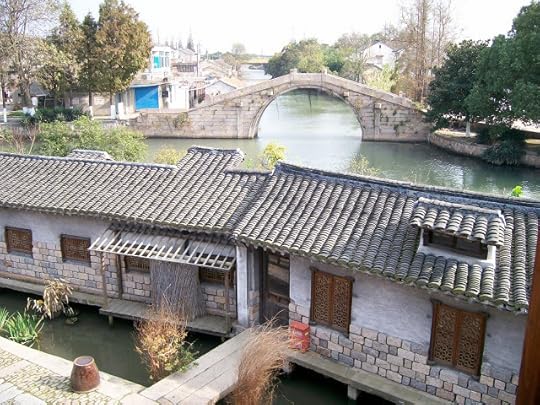 View of waterways from Jinze Craft Museum
View of waterways from Jinze Craft Museum

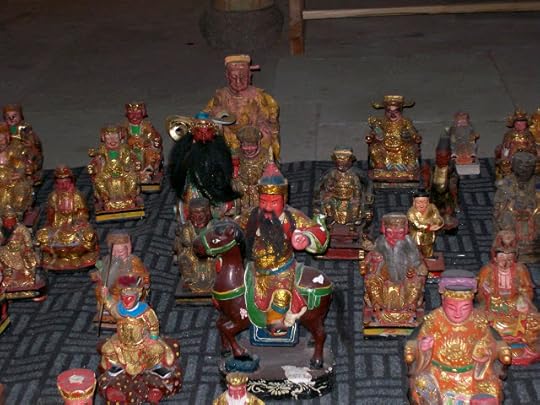
Published on December 11, 2011 06:38
October 31, 2011
Images of Poetry from Art launch at Tate Modern
Here are some official photos of the Poetry from Art pamphlet launch on 24th September 2011, taken by the Tate photographer Ana Escobar. I particularly love the ones bathed in Miró cerulean, so apt, as Miró's triptych Blue I, II, III inspired many poems in the anthology. The pamphlet is now for sale in the Tate Modern bookshop for £4.95. (Please do not use any of these images without permission from Tate.) The next Poetry from Art course starts on Monday 20th February. Bookings will open when the course goes up on the Tate website over Christmas.
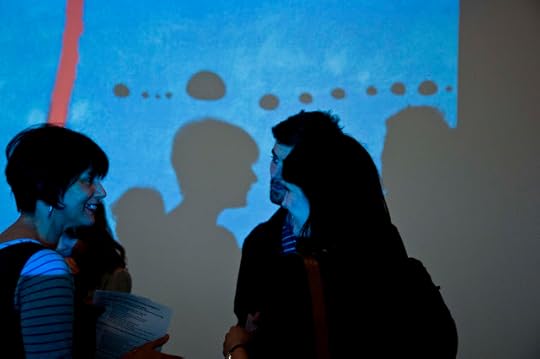 One of the readers Jac Cattaneo in front of the slide of Joan Miró's Blue II.
One of the readers Jac Cattaneo in front of the slide of Joan Miró's Blue II.Copyright Tate, photographed by Ana Escobar, Poetry from Art book launch 2011.
 Audience of 130 in the East Room waiting for the readings to start. Marko Daniel, Convener of Adult Programmes and co-curator of the Miró exhibition (in the black suit standing by far window), opened the event. Copyright Tate, photographed by Ana Escobar, Poetry from Art book launch 2011.
Audience of 130 in the East Room waiting for the readings to start. Marko Daniel, Convener of Adult Programmes and co-curator of the Miró exhibition (in the black suit standing by far window), opened the event. Copyright Tate, photographed by Ana Escobar, Poetry from Art book launch 2011.
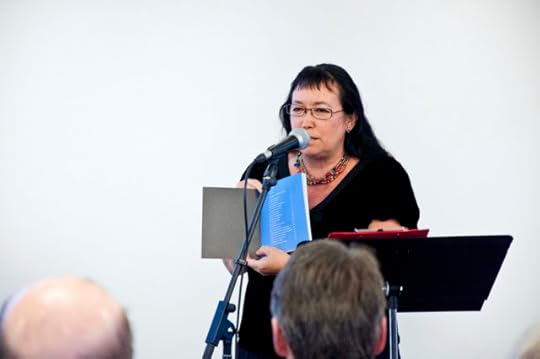 I introduced the anthology and the twenty readers who had attended my summer course.
I introduced the anthology and the twenty readers who had attended my summer course. Copyright Tate, photographed by Ana Escobar, Poetry from Art book launch 2011.
 View from the East Room over the Thames after nightfall
View from the East Room over the Thames after nightfallCopyright Tate, photographed by Ana Escobar, Poetry from Art book launch 2011.
Published on October 31, 2011 08:11
October 23, 2011
'My Father's City': new poem in Guernica magazine
I'm delighted that Guernica magazine has published my new poem 'My Father's City' in their October issue guest edited by the wonderful poet Brian Turner. You can read the poem here and there's also an audio clip of me reading it. The poem is from a sequence I'm currently working on, with the city of Paris and my father as its dual theme, twelve years on from the father poems of my second collection
The Zoo Father
which featured Amazonian imagery.
Here's one of the chimera on the south tower of Notre-Dame, which overlooks the Notre-Dame hotel where he lived for a few years. The hotel is on the corner of the Quai St Michel just under the devil's shoulder.
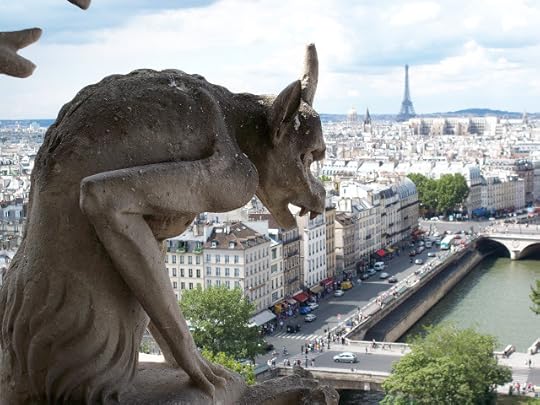

Here's one of the chimera on the south tower of Notre-Dame, which overlooks the Notre-Dame hotel where he lived for a few years. The hotel is on the corner of the Quai St Michel just under the devil's shoulder.

Published on October 23, 2011 09:53
October 10, 2011
Rue du Pot de Fer, Paris, September 2011
This is the street I stayed in for two weeks this summer, researching for my novel and sixth poetry collection. I was on the fifth floor under the roofs, so it was quiet, unless I opened the skylight which faced onto the street. This accordian player played every night, always dressed in that suit and white spats. My flat faced the back, with a view of the Pantheon and rooftops of the Quartier Latin. I had a terrace with a young aspen which seemed to have rooted in thin air and which swished in the breeze, and a panoramic view of the skyscape which made me feel lonely but light-headed, a good mood for writing.
George Orwell lived at 6 Rue du Pot de Fer, just a few doors away, when he wrote Down and Out in Paris and London, but it's more affluent now. This narrow cobbled street is just off the Rue Mouffetard which leads onto Rue Descartes, where Verlaine lived. Opposite the house where he died (now a restaurant) is a pub Le Bateau Ivre. And a few steps further down is a little green patch and a wall with the poem 'Passerby' by Yves Bonnefoy, next to a fresco of the Blue Philosopher's Tree by Pierre Alechinsky.
My father lived just round the corner from here the last few years of his life, in Rue Clovis, in a tiny studio flat in an apartment block right next to the oldest city wall of Paris, built in the reign of King Philip Augustus. Before then, my father lived in various hotels facing Notre-Dame, including Les Argonautes in Rue de la Huchette and the Hôtel Notre-Dame on the Quai St Michel, where he would have been overlooked by the gargoyles. And before that? Marseille, Lyon, the Algerian mountains – a shifting life under an assortment of names appropriate for a vanished person.
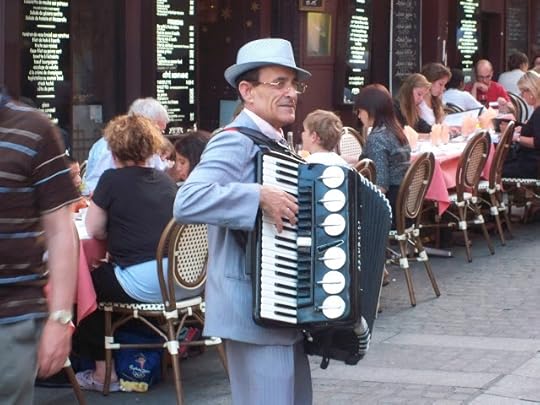

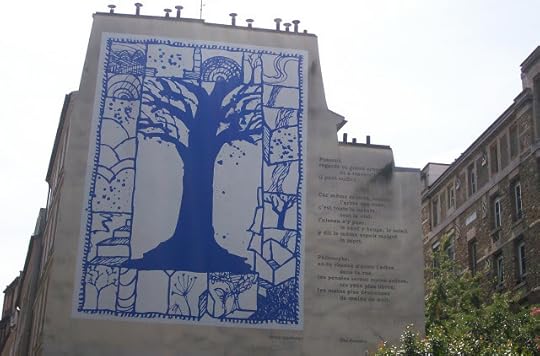


George Orwell lived at 6 Rue du Pot de Fer, just a few doors away, when he wrote Down and Out in Paris and London, but it's more affluent now. This narrow cobbled street is just off the Rue Mouffetard which leads onto Rue Descartes, where Verlaine lived. Opposite the house where he died (now a restaurant) is a pub Le Bateau Ivre. And a few steps further down is a little green patch and a wall with the poem 'Passerby' by Yves Bonnefoy, next to a fresco of the Blue Philosopher's Tree by Pierre Alechinsky.
My father lived just round the corner from here the last few years of his life, in Rue Clovis, in a tiny studio flat in an apartment block right next to the oldest city wall of Paris, built in the reign of King Philip Augustus. Before then, my father lived in various hotels facing Notre-Dame, including Les Argonautes in Rue de la Huchette and the Hôtel Notre-Dame on the Quai St Michel, where he would have been overlooked by the gargoyles. And before that? Marseille, Lyon, the Algerian mountains – a shifting life under an assortment of names appropriate for a vanished person.




Published on October 10, 2011 00:02
September 27, 2011
The Poetry from Art pamphlet is launched!
Last Saturday was the launch of the second Poetry from Art at Tate Modern pamphlet anthology. 21 poets who attended my six-week summer course read their poems: one from the anthology and one other written on the course, or on previous courses this year. I was quite nervous – there were beginners as well as advanced writers, and a few had never read before – but I needn't have worried. They all did well and the capacity audience was most appreciative. I reckon there were about 140 in the audience, and a great atmosphere. The last reader, Karen McCarthy Woolf, gave a vote of thanks, then Bea Colley popped out with an enormous bouquet!
Though it's the readers I want to celebrate, and especially the way the less experienced writers among them good-humouredly accepted the email editing process we went through with their poems. They also had feedback from their peers during the course, when we would cluster into small groups to offer constructive criticism. The anthology is now for sale only in the Tate Modern bookshop. The next Poetry from Art course will be 20 Feb – 26 March 2012. It will go up and open for bookings on the Tate website around Christmas.
This first photo of the event was taken by Anne Welsh, who has attended all my Tate courses for six years! The second photo of her reading was taken by Marc Mathison. It was hard to take pictures of the readings because I was projecting a large slideshow of the artworks that inspired each poem to the left of the readers, and we couldn't include those in public photos. The evening was dominated by Joan Miró's fabulous triptych Blue I, II, II so we were bathed in a cerulean glow.
Works by Ana Mendieta (Blood and Feathers #2) and Lamia Joreige (Objects of War) also featured frequently, in contrast to the meditative blues. Our venue was the East Room on Level 7 at Tate Modern, with panoramic views of the Thames and London and the evening was opened with a very warm and welcoming speech by Marko Daniel, Convener of Adult Porgrammes and co-curator of the Miró exhibition.
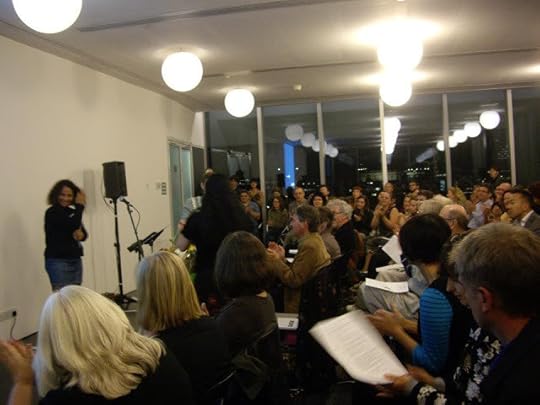 Karen McCarthy Woolf, the last reader, gives a vote of thanks. Photo credit Anne Welsh.
Karen McCarthy Woolf, the last reader, gives a vote of thanks. Photo credit Anne Welsh.
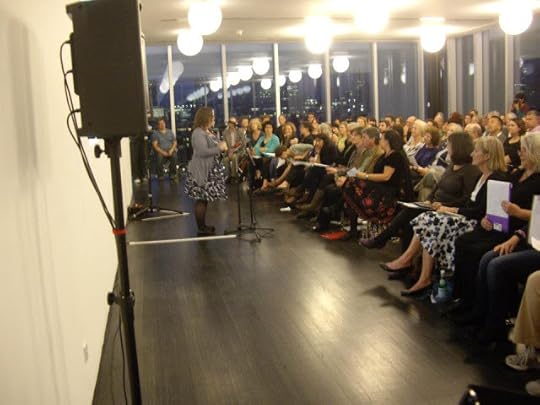 Anne Welsh reading her two poems. Photo credit Marc Mathison.
Anne Welsh reading her two poems. Photo credit Marc Mathison.
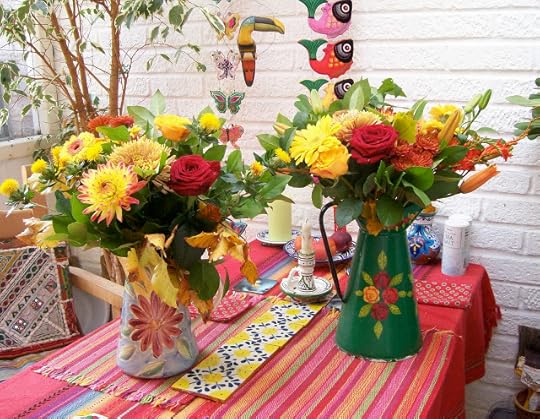 The bouquet divided into two jugs.
The bouquet divided into two jugs.
 And here are copies of the pamphlet anthology, a suitably Miró blue (and black).
And here are copies of the pamphlet anthology, a suitably Miró blue (and black).

Though it's the readers I want to celebrate, and especially the way the less experienced writers among them good-humouredly accepted the email editing process we went through with their poems. They also had feedback from their peers during the course, when we would cluster into small groups to offer constructive criticism. The anthology is now for sale only in the Tate Modern bookshop. The next Poetry from Art course will be 20 Feb – 26 March 2012. It will go up and open for bookings on the Tate website around Christmas.
This first photo of the event was taken by Anne Welsh, who has attended all my Tate courses for six years! The second photo of her reading was taken by Marc Mathison. It was hard to take pictures of the readings because I was projecting a large slideshow of the artworks that inspired each poem to the left of the readers, and we couldn't include those in public photos. The evening was dominated by Joan Miró's fabulous triptych Blue I, II, II so we were bathed in a cerulean glow.
Works by Ana Mendieta (Blood and Feathers #2) and Lamia Joreige (Objects of War) also featured frequently, in contrast to the meditative blues. Our venue was the East Room on Level 7 at Tate Modern, with panoramic views of the Thames and London and the evening was opened with a very warm and welcoming speech by Marko Daniel, Convener of Adult Porgrammes and co-curator of the Miró exhibition.
 Karen McCarthy Woolf, the last reader, gives a vote of thanks. Photo credit Anne Welsh.
Karen McCarthy Woolf, the last reader, gives a vote of thanks. Photo credit Anne Welsh. Anne Welsh reading her two poems. Photo credit Marc Mathison.
Anne Welsh reading her two poems. Photo credit Marc Mathison. The bouquet divided into two jugs.
The bouquet divided into two jugs. And here are copies of the pamphlet anthology, a suitably Miró blue (and black).
And here are copies of the pamphlet anthology, a suitably Miró blue (and black).
Published on September 27, 2011 11:04
September 18, 2011
Preview of a pamphlet anthology: Poetry from Art at Tate Modern 2011
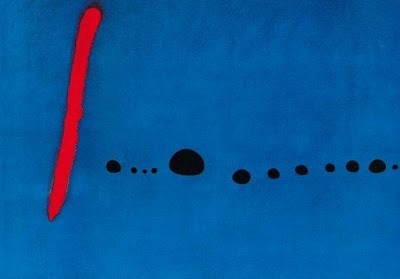
Next Saturday, 24th September, will be the launch of the pamphlet anthology I have just edited: Poetry from Art at Tate Modern 2011 . Here is a preview of two poems from the pamphlet (scroll down).
Participants in Tate Modern's Poetry from Art courses, led by Pascale Petit, present a pamphlet of their work, including poems after Miró and responses to the permanent displays. The readings will be illustrated with a slideshow and opened by Marko Daniel who is Convenor of Adult Programmes and co-curator of the Miró show. The anthology will be for sale that evening then afterwards in the Tate Modern bookshop.
Saturday 24 September 2011 18.45–21.00
Free entry, readings, great views and wine.
Tate Modern Level 7 East Room
Bankside, London SE1 9TG
Free, no booking necessary
Tel: 020 7887 8888 visiting.modern@tate.org.uk
http://www.tate.org.uk/modern/eventseducation/coursesworkshops/24136.htm
The contributors are: Karen McCarthy Woolf, Matthew Paul, Anne Welsh, Jac Cattaneo, Wei-Lyn Loh, Margaret Beston, Bea Colley, Cath Kane, Kaye Lee, Seraphima Kennedy, Marc Mathison, Ali Thurm, Elizabeth Horsley, Mary Whistler, Andrea Robinson, Angela Dock, Beatriz Echeverri, Natasha Morgan, Michael Berg, Christine Voge, Ipsita Sinha and Laura-Jane Foley
Elizabeth Horsley's poem is a response to a memorable session we spent in one of the octagonal rooms of the Joan Miró: The Ladder of Escape exhibition, immersed in the glow of the meditative Blue I, II, II triptych. Miró's paintings are poems in themselves so it isn't surprising that his paintings generated many poems.
Elizabeth Horsley
The wardrobe is painted blue inside
after Blue I, II, III by Joan Miró
The wardrobe is painted blue inside
and when I open it
the mirrored doors
welcome me in,
channel every side of me through.
I could step inside
let that orange silk dress
swish against me
like a swarm of butterflies;
I could be part of it all –
a glass box full of kingfishers,
but I would rather be outside
dressed in a long shift
of Madonna-blue cotton,
lying in the summer grass
looking at the sky.
I would rather float
in the Hebridean sea
and let the seals watch me
as they watched me once before.
If I could lie in that blue
that would be enough.
In the autumn term, when Ana Mendieta's video Blood and Feathers #2 was on display in the Energy and Process wing, we watched Mendieta perform a ritual on a riverbank, which consisted of her pouring blood over herself then rolling onto white feathers and holding her arms out like wings. This inspired poems about rites of passage and ritual dress and the following is Natasha Morgan's personal response:
Natasha Morgan
On Her Very Last Day
after Blood and Feathers #2 by Ana Mendieta
When my mother lay
in her hospital bed
on her very last afternoon in November
six years ago,
when the sun broke through the plastic strips
that layered the windows
of that suburban room,
promising one last golden moment,
when I slipped outside
into her garden, for roses,
with secateurs in hand, for the pink roses
to take them in their full gloryfor the very last time,
when I returned with my
arms full, they fell all around, all around,
because she had not waited for them
or for me.
And so I sat with her,
both of us still, but she more still than me.
And I washed her body and edged her stiffening limbs
into her white cotton nightdress, fresh that day
and spread a white cashmere shawl
to cover her right down to her feet,
and gave her my socks
for the journey.
And when all was done, and well done, and done in good time
I sat with her in the smell of the roses
that rose around us as the sun went down.

Published on September 18, 2011 10:55
September 15, 2011
Return to the Ménagerie in the Jardin des Plantes
It's fourteen years since I first visited the Ménagerie in the Jardin des Plantes of Paris, when I was writing
The Zoo Father
. I used to go there every day then, and first went back last year. There are not so many big cats now – no black jaguar, no pumas, no lions. But there is a snow leopard, as there was then, in the Fauverie. No English word quite captures the French word 'Fauverie'; I've seen it translated as 'big cat house', but fauve means wild beast. In a way it's good there aren't so many big cats because the cages are too small as this is the second oldest zoo in the world, an old-fashioned one. There's more conservation work going on now and the zoo was full of young animals born in the spring or earlier this summer. I saw a young yak, and a Przewalski foal, but the mother was still with her doted companion, a nanny goat, which I must confess last year I mistook for her rather shaggy foal until the horns came into view!
As before, I searched for one of my favourites, the Amazonian king vulture. He's the gaudy headed one below. Twelve years ago there was a baby king vulture in the nursery, in a baby's playpen. As I was wandering around, trying to see as much as possible before closing time, I heard a maniacal laugh and made for the source of it: two laughing kookaburras. They set the macaws off who screeched at each other and started to do acrobatics on their bars. The whole zoo at that point seemed to wake up and become vibrantly alert, disregarding the humans. It gave me a headache as I dashed from one cage to another watching them.
I returned to the little farm to feed the goats prickly leaves. They licked my hands and I stroked their bristly heads and horns. No keepers were there and families were feeding them crackers and bread. One of my favourite paths is along the owl cages. I love reading their names in French as much looking at them. The eagle owl is 'grand-duc'. The great grey owl looked like a ghost from a Max Ernst forest and the snow owl was still there, though I suppose he's a new one. I particularly love his name 'harfang des neiges', though still prefer the English 'snow owl', and the word 'owl' to the French words for owl, good as they are: chouette, harfang, hibou, effraie (barn-owl, screech owl, fright).
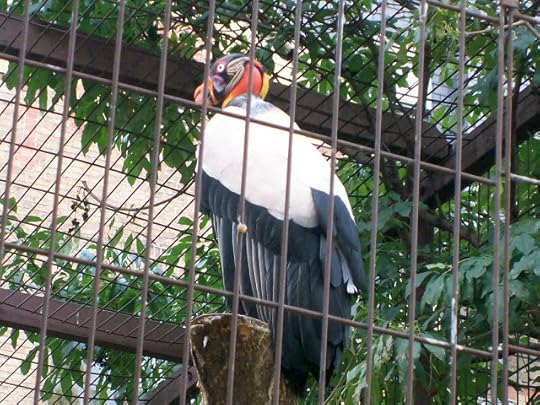 The king vulture. His mate was eating a carcass on the floor.
The king vulture. His mate was eating a carcass on the floor.
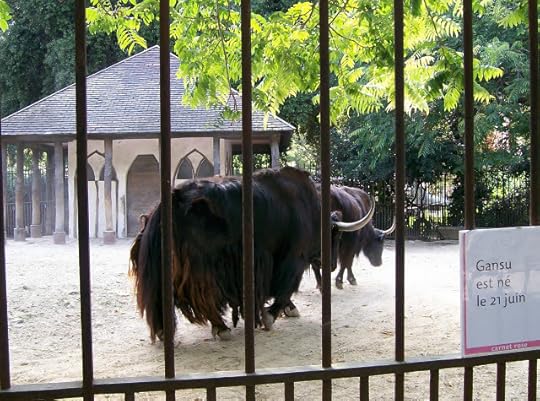 The yak mother and son
The yak mother and son
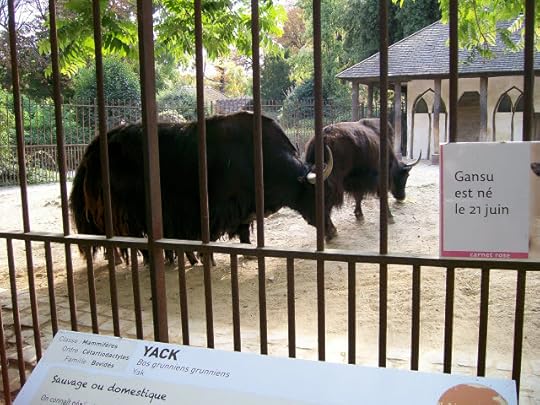
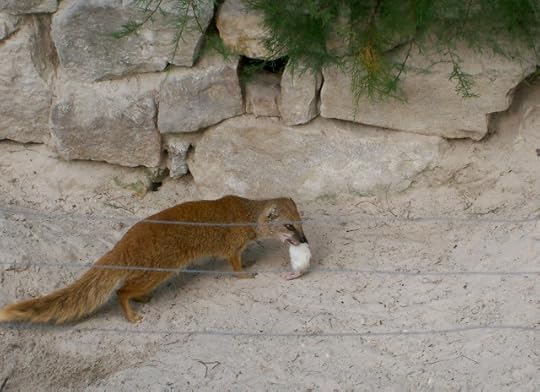 Can't remember what this creature was but the three of them were very busy eating rats
Can't remember what this creature was but the three of them were very busy eating rats
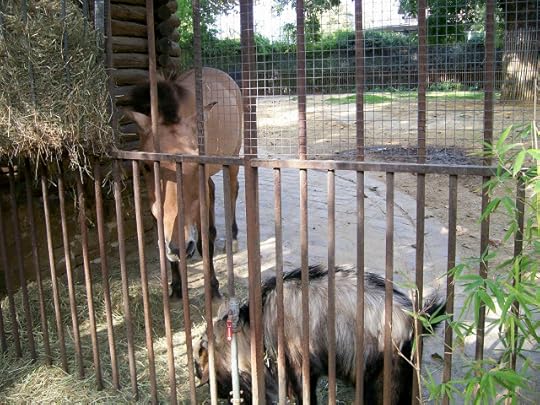 The przeswalski mare with her lifelong companion, a goat.
The przeswalski mare with her lifelong companion, a goat.
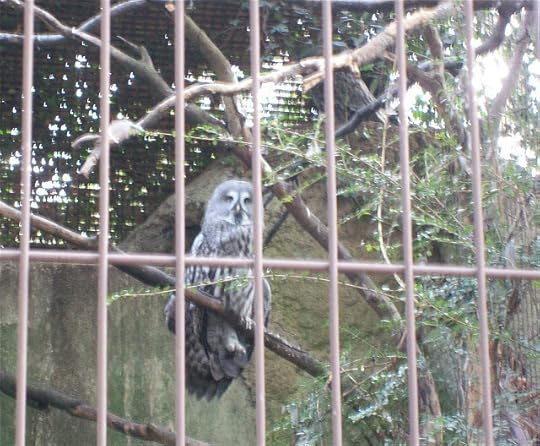 Great grey owl
Great grey owl
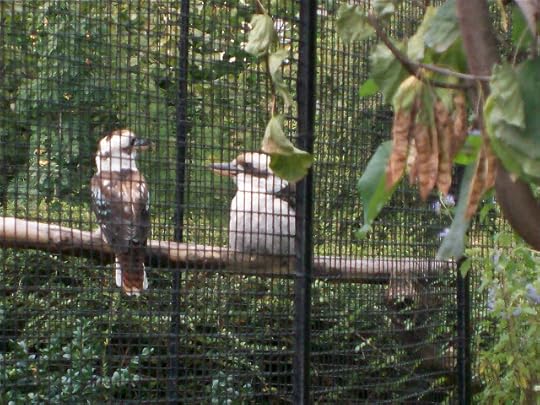 The kookaburras get going
The kookaburras get going
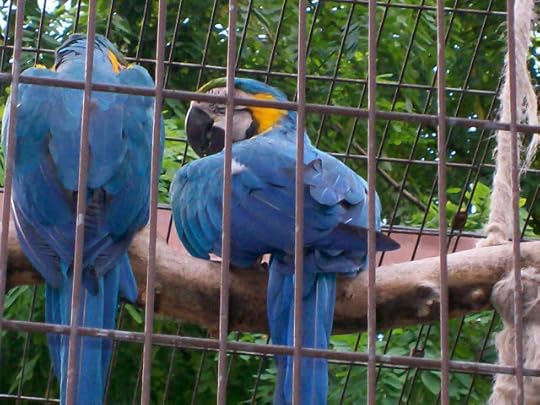 The macaws listen
The macaws listen
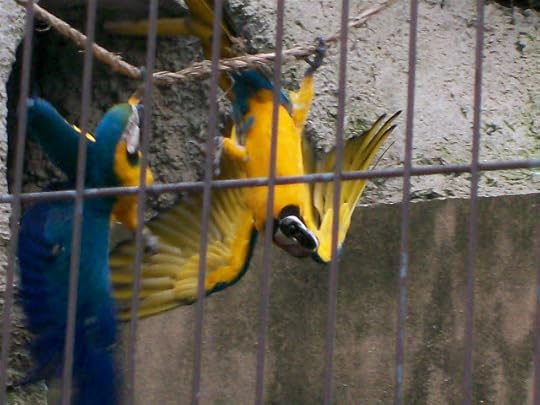
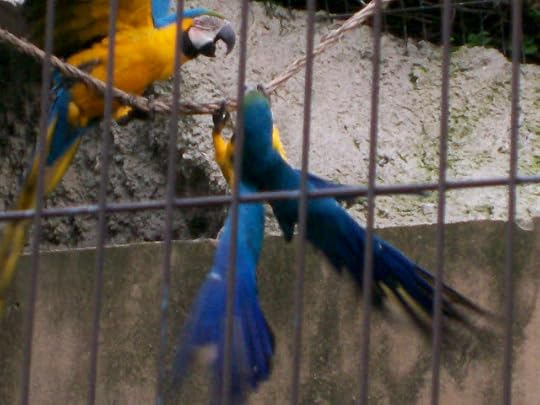 and join in
and join in
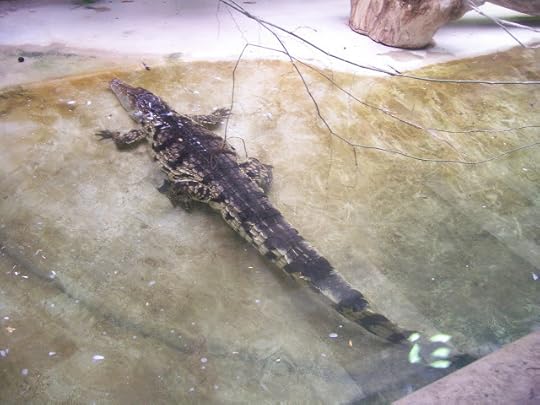 Nile croc
Nile croc
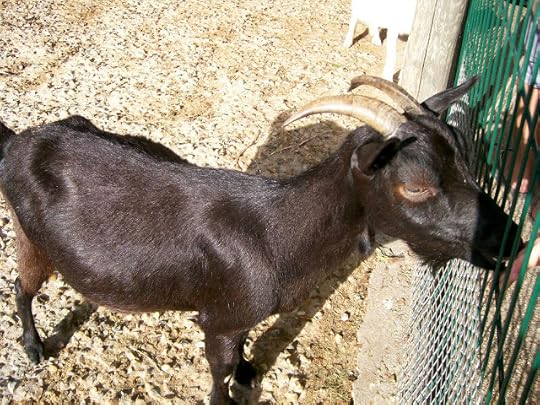 Feeding the goats
Feeding the goats

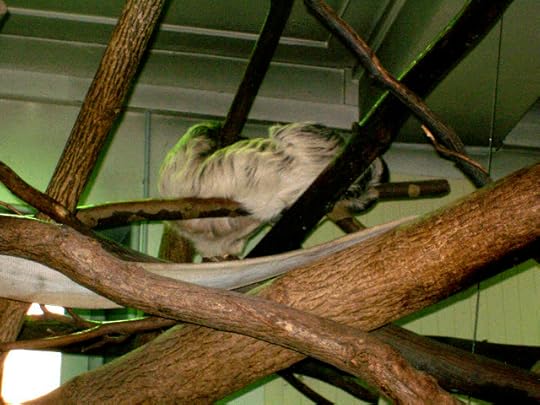 Le Paresseux – sloth, in his new rainforest enclosure
Le Paresseux – sloth, in his new rainforest enclosure

As before, I searched for one of my favourites, the Amazonian king vulture. He's the gaudy headed one below. Twelve years ago there was a baby king vulture in the nursery, in a baby's playpen. As I was wandering around, trying to see as much as possible before closing time, I heard a maniacal laugh and made for the source of it: two laughing kookaburras. They set the macaws off who screeched at each other and started to do acrobatics on their bars. The whole zoo at that point seemed to wake up and become vibrantly alert, disregarding the humans. It gave me a headache as I dashed from one cage to another watching them.
I returned to the little farm to feed the goats prickly leaves. They licked my hands and I stroked their bristly heads and horns. No keepers were there and families were feeding them crackers and bread. One of my favourite paths is along the owl cages. I love reading their names in French as much looking at them. The eagle owl is 'grand-duc'. The great grey owl looked like a ghost from a Max Ernst forest and the snow owl was still there, though I suppose he's a new one. I particularly love his name 'harfang des neiges', though still prefer the English 'snow owl', and the word 'owl' to the French words for owl, good as they are: chouette, harfang, hibou, effraie (barn-owl, screech owl, fright).
 The king vulture. His mate was eating a carcass on the floor.
The king vulture. His mate was eating a carcass on the floor. The yak mother and son
The yak mother and son
 Can't remember what this creature was but the three of them were very busy eating rats
Can't remember what this creature was but the three of them were very busy eating rats The przeswalski mare with her lifelong companion, a goat.
The przeswalski mare with her lifelong companion, a goat. Great grey owl
Great grey owl  The kookaburras get going
The kookaburras get going The macaws listen
The macaws listen

 and join in
and join in Nile croc
Nile croc Feeding the goats
Feeding the goats
 Le Paresseux – sloth, in his new rainforest enclosure
Le Paresseux – sloth, in his new rainforest enclosure
Published on September 15, 2011 02:47
September 12, 2011
Photos of the Marché aux Oiseaux in Paris
One of the things that drew me to write in Paris a second time this summer was the discovery that there is a Marché aux Oiseaux on the Île de la Cité, just behind the esplanade of Notre Dame. It's been there since 1808 and is on Sundays. The rest of the week it's a flower market. Some of the cages have one bird in, others are sadly crammed with budgies, quails, lovebirds and cockatiels.
There were kakarikis – red-crowned parakeets, turtle doves, Japanese sparrows, African greys and many more, even rabbits and three particularly cute black and white rats. They all made quite a noise among the flowers and accessories, the vistas of hanging empty cages for sale. Some birds seemed treated with care, many not. I was there on a research mission but what a feast of colour! I witnessed a few sales. A sudden squawk and a hand was thrust into a cage then out, a tiny flurry of canary feathers dispatched into a paper box and one yellow feather left floating down.
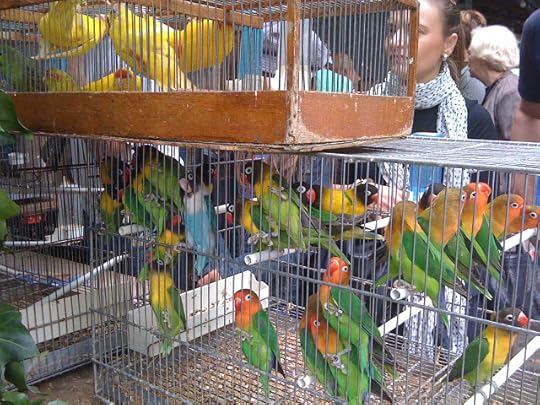
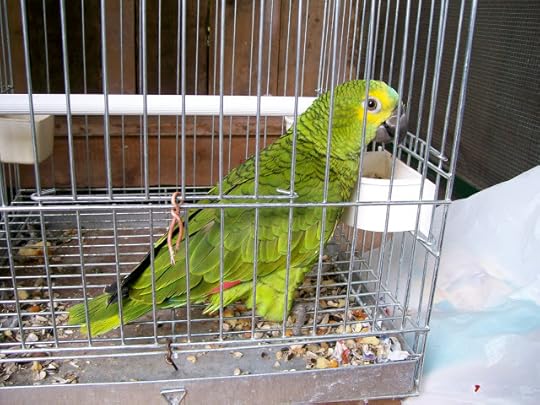
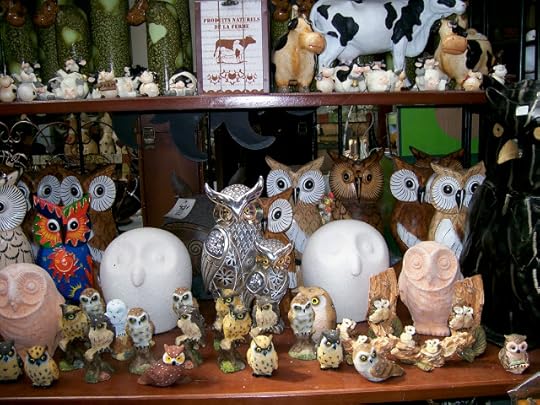

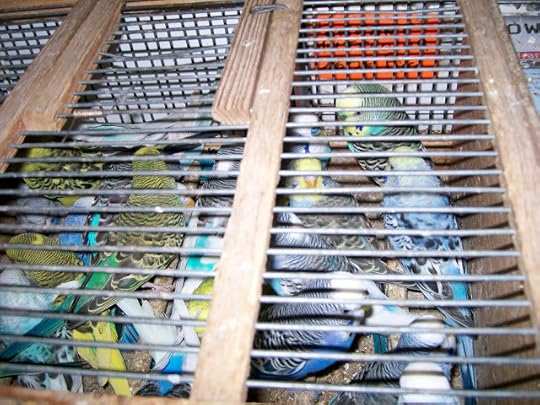

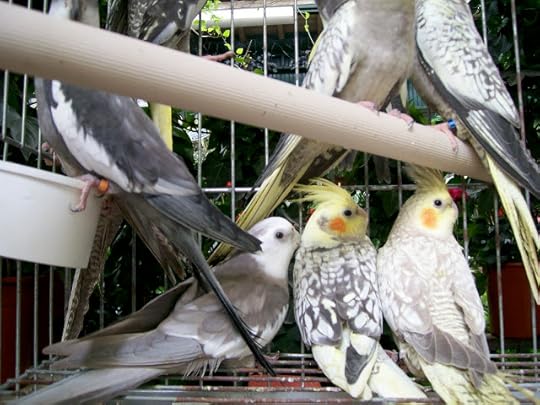
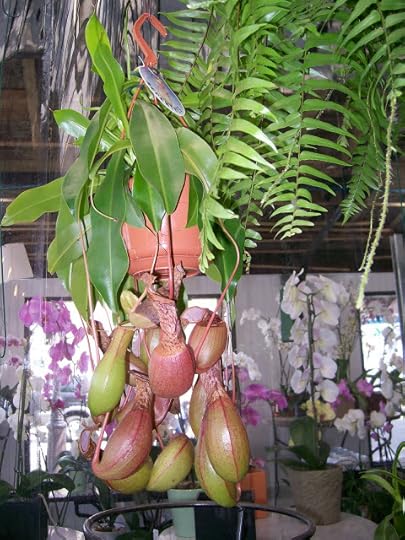

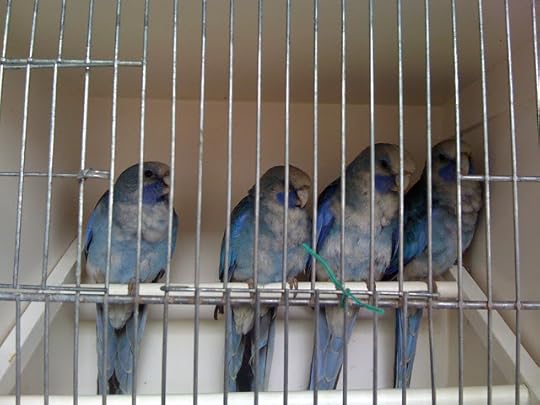
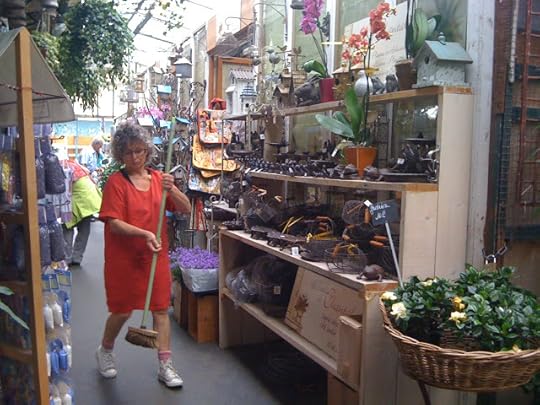
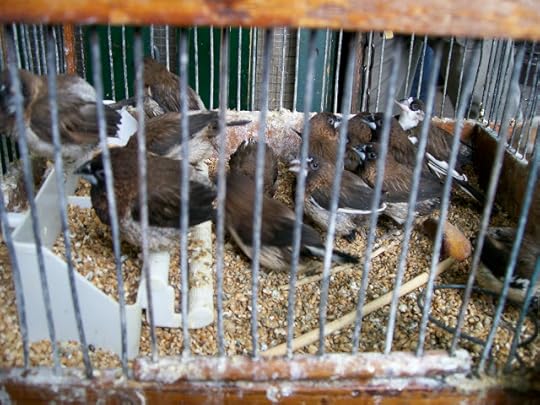
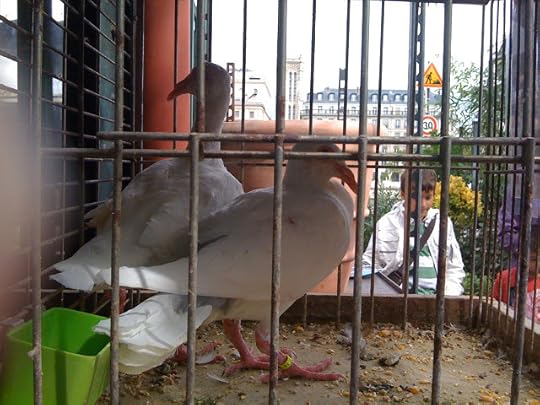
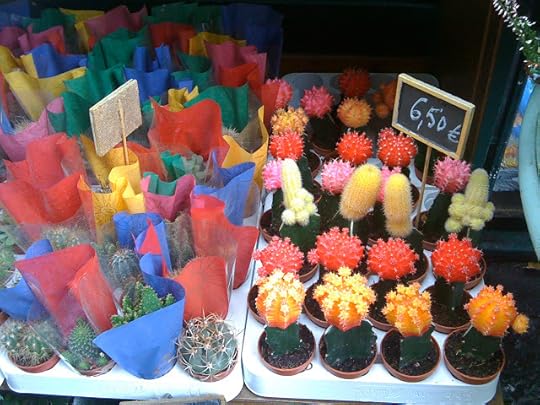

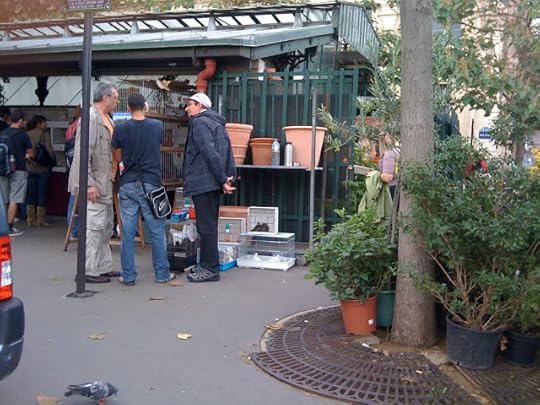
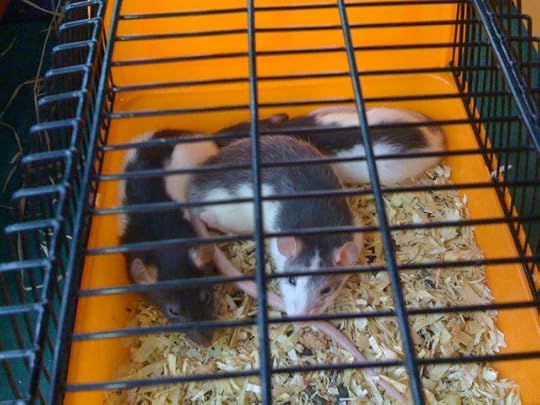
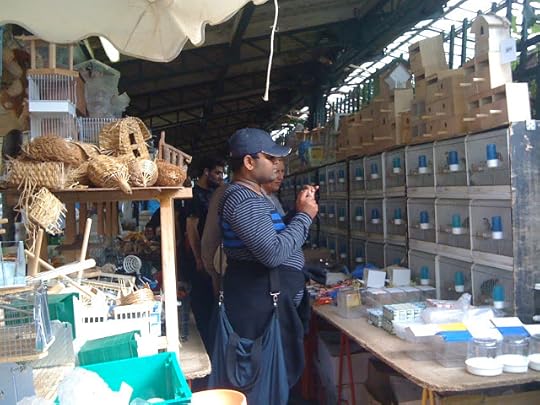
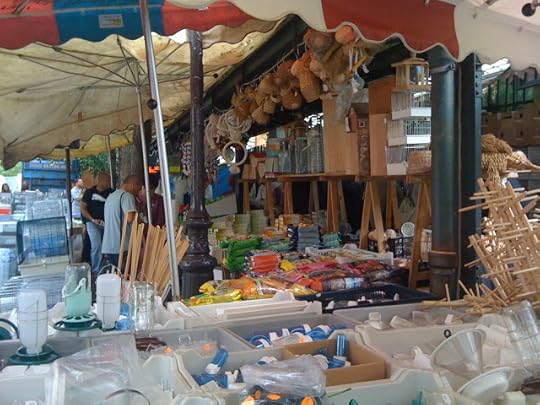

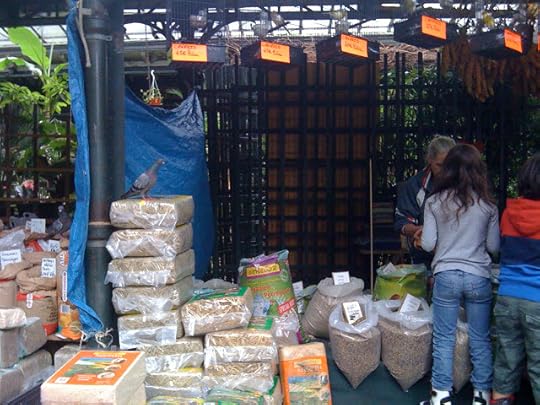

There were kakarikis – red-crowned parakeets, turtle doves, Japanese sparrows, African greys and many more, even rabbits and three particularly cute black and white rats. They all made quite a noise among the flowers and accessories, the vistas of hanging empty cages for sale. Some birds seemed treated with care, many not. I was there on a research mission but what a feast of colour! I witnessed a few sales. A sudden squawk and a hand was thrust into a cage then out, a tiny flurry of canary feathers dispatched into a paper box and one yellow feather left floating down.





















Published on September 12, 2011 11:58
September 8, 2011
Hand-feeding the Notre Dame sparrows
Every time I stay in Paris there are new surprises. One of the highlights of last week's visit was hand-feeding the sparrows in front of Notre Dame. The box hedges on the parvis are bustling with them, mostly juveniles – their breasts and wings still downy. Every day I was drawn back. The first day I just watched as two regulars hand-fed them and a few tourists joined in. The second day one of the men gave me a handful of birdseed and I stood up on the low concrete wall around the privet and held out my hand. I waited, and quite soon a young female sparrow hopped onto my fingers. Her claws grasped me and she bent down and picked up a seed with her yellow and fawn beak. It took her quite a while to crack and eat it and I managed to glimpse her peach tongue. She stayed on my hand for half an hour, batting off all intruders by raising her wings and fiercely beating them, cheeping at the same time.
The second day I had up to three sparrows feeding together, some fully grown males as well as females and juveniles. The males have darker colouring around their heads, black and brown markings. By this time I'd been to the Marché aux Oiseaux and bought some small wild-bird grains. On the third day (I would pass there on my evening walk after a day's writing) I had six sparrows feeding together, males and females. At one point pigeons landed and starlings. That day I fed the moineaux for an hour and a half, as I was leaving the next morning, to return to London where sparrows are scarce. These pictures were taken on my iPhone with my free hand, though the last six-sparrow day I didn't take any as I wanted to just concentrate on the experience. It was the same with Notre Dame, every time I looked at the cathedral, especially the facade and towers, I saw more. I looked and looked harder.

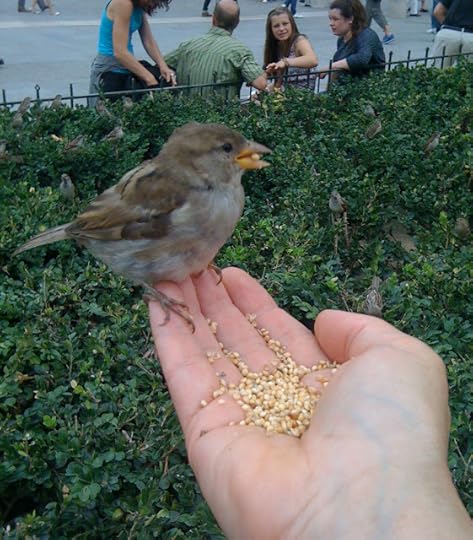 The young female who stayed on my hand for half an hour the first day
The young female who stayed on my hand for half an hour the first day
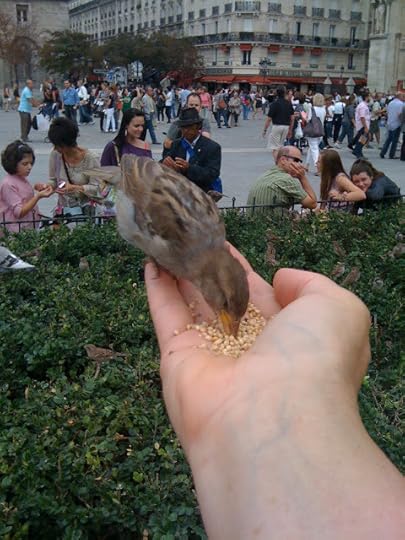


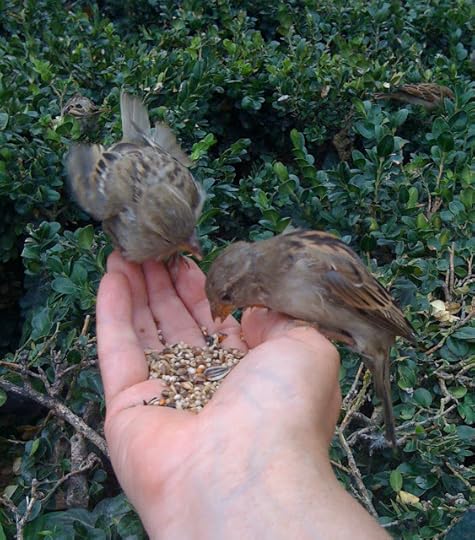 Here you can see the beginning of the sending-off display, as one bird starts to raise her wings to beat them at the other.
Here you can see the beginning of the sending-off display, as one bird starts to raise her wings to beat them at the other.

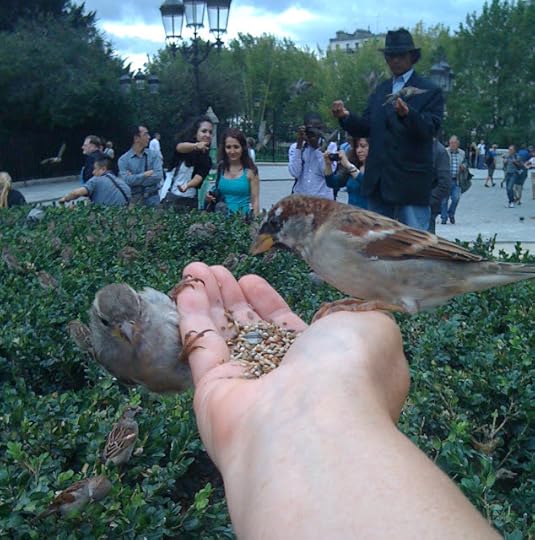 The man with the black hat is one of the two regulars. They come every day, all day. The other one told me he comes because it makes him feel better when things aren't going well.
The man with the black hat is one of the two regulars. They come every day, all day. The other one told me he comes because it makes him feel better when things aren't going well. 
The second day I had up to three sparrows feeding together, some fully grown males as well as females and juveniles. The males have darker colouring around their heads, black and brown markings. By this time I'd been to the Marché aux Oiseaux and bought some small wild-bird grains. On the third day (I would pass there on my evening walk after a day's writing) I had six sparrows feeding together, males and females. At one point pigeons landed and starlings. That day I fed the moineaux for an hour and a half, as I was leaving the next morning, to return to London where sparrows are scarce. These pictures were taken on my iPhone with my free hand, though the last six-sparrow day I didn't take any as I wanted to just concentrate on the experience. It was the same with Notre Dame, every time I looked at the cathedral, especially the facade and towers, I saw more. I looked and looked harder.

 The young female who stayed on my hand for half an hour the first day
The young female who stayed on my hand for half an hour the first day


 Here you can see the beginning of the sending-off display, as one bird starts to raise her wings to beat them at the other.
Here you can see the beginning of the sending-off display, as one bird starts to raise her wings to beat them at the other.
 The man with the black hat is one of the two regulars. They come every day, all day. The other one told me he comes because it makes him feel better when things aren't going well.
The man with the black hat is one of the two regulars. They come every day, all day. The other one told me he comes because it makes him feel better when things aren't going well.
Published on September 08, 2011 02:18
August 23, 2011
The Languedoc, August 2011
I have been visiting the Languedoc Rousillion since I was a child, when my mother bought a steep terraced vineyard near Lodève, with two shepherds' stone huts and a deep banked stream in the sous-bois. We used to camp in the stone huts, after the fire brigade had smoked out the hornets' nests. There are no vines left now but those childhood summers have drawn me back again and again to this wild land with its limestone moors and gorges.
This August, B and I rented a house up the remotest hill of the Orb Valley for one week. The evening we arrived the snowy tree crickets' chirrs filled the house from every window, a sound much like moonlight if it had a voice, more otherworldly than the daytime cicadas, another sound I love. Ours was the last house of the hamlet of Le Lau and the surrounding woods are wild boar hunting grounds. One morning I heard the dogs and hunters capturing a boar; its shrieks gave me a migraine. At night I heard genets, which sound like a cross betweeen a cat and a fox. I saw one darting across the car park when we visited the Gorge de l'Hèric, spotted and with a long bushy tail. On our last night, we heard a boar snuffling and grunting just a few feet away from us as we sat on the unfenced terrace. It was enthralling to be so close but after standing closer to peer at him (he could have charged!) we decided to retreat to safety.
To get to the Gorge du Tarn, Gorge de la Jonte (and its vultures) and the Chaos of Montpellier le Vieux, B had to drive up the Pas de l'Escalette. This is a spectacular pass from the Languedocien plain to the Causses (limestone moors) of the most southerly Massif Central range. The A75 autoroute recently replaced the old A9 road, which we both remember, and that, in its time, replaced an iron ladder for passengers to disembark from their carriages, climb up the cliff, then continue in another carriage. Now, there is a series of tunnels that cuts through then winds round the Steps of the Ladder. It's only this time that I realised just how much this landscape paved the way for my obsession with Venezuela's Lost World, with its cliff-bordered sky-islands. The causses and gorges were the prototype, so that when I journeyed to the Lost World I recognised it as home, though it plainly wasn't, and is actually hostile in its remoteness and grandeur.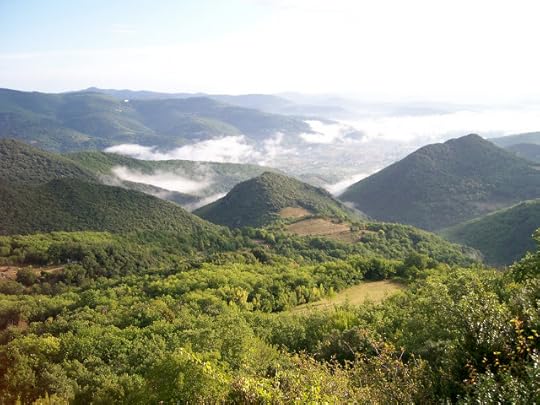 View from the lane above Le Lau across the Orb Valley, early morning
View from the lane above Le Lau across the Orb Valley, early morning
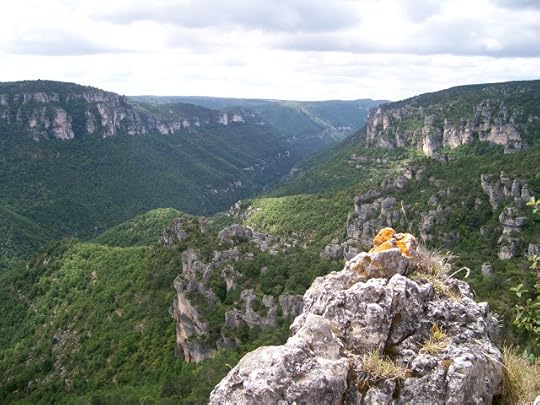 View from Chaos of Montpellier le Vieux
View from Chaos of Montpellier le Vieux
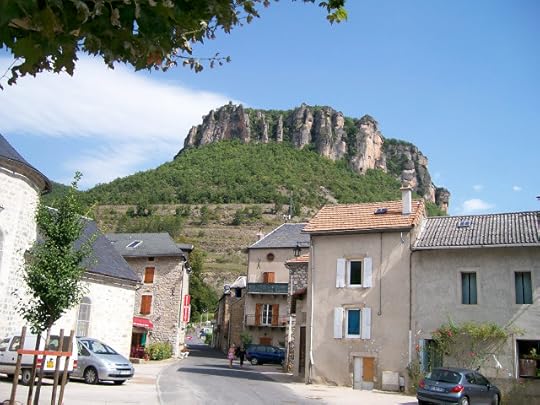 Village of Trèves on the road to Gorge du Tarn
Village of Trèves on the road to Gorge du Tarn
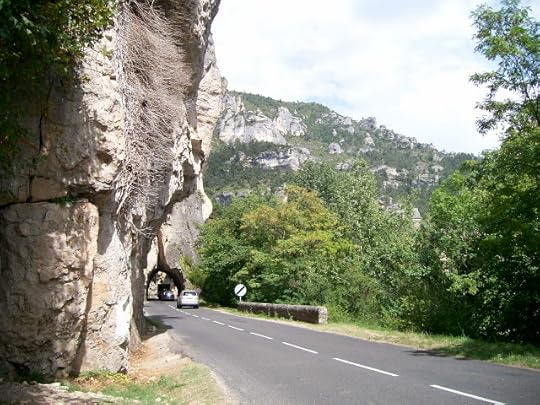 Gorge du Tarn
Gorge du Tarn
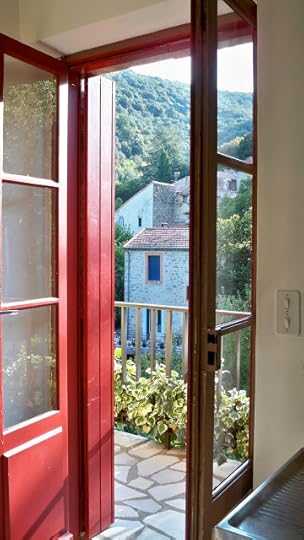 The medieval and higgledy hamlet of Le Lau from the kitchen door
The medieval and higgledy hamlet of Le Lau from the kitchen door
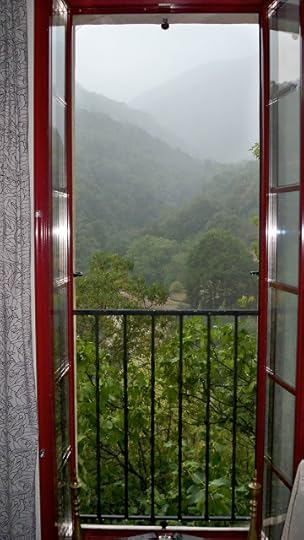 The sudden storm from the living-room window, thunder echoed around the hills and the wind was wild!
The sudden storm from the living-room window, thunder echoed around the hills and the wind was wild!
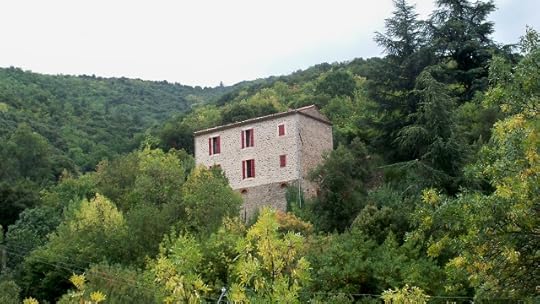 The house from the lane to Le Lau
The house from the lane to Le Lau
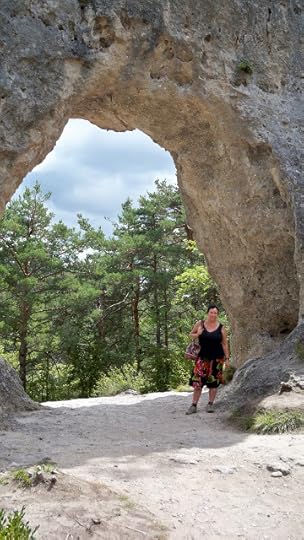 Chaos of Montpellier le Vieux on the Causse Noir
Chaos of Montpellier le Vieux on the Causse Noir
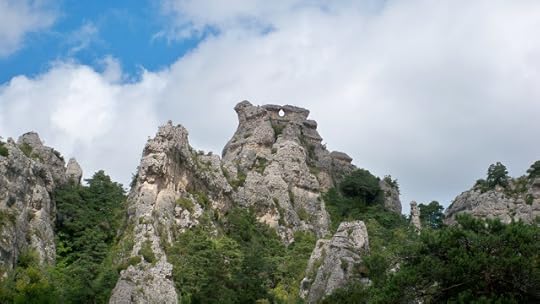 Chaos of Montpellier le Vieux is just like the tops of Venezuela's plateaus, with eroded rock shapes, though these are limestone and those are quartzite sandstone.
Chaos of Montpellier le Vieux is just like the tops of Venezuela's plateaus, with eroded rock shapes, though these are limestone and those are quartzite sandstone.
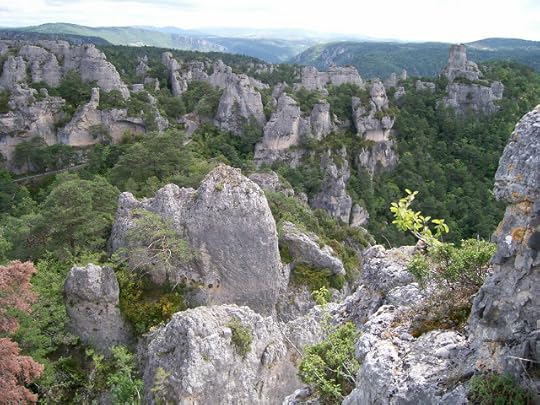 A typical panorama
A typical panorama
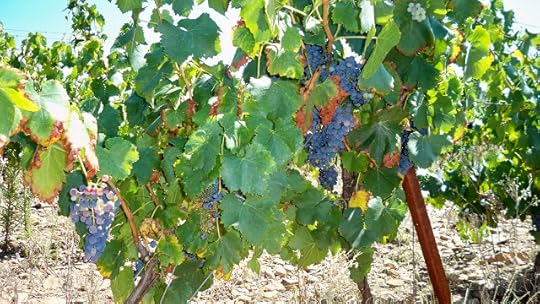 Vineyards in the Orb Valley, on our way to the Forest of War Veteran Writers
Vineyards in the Orb Valley, on our way to the Forest of War Veteran Writers
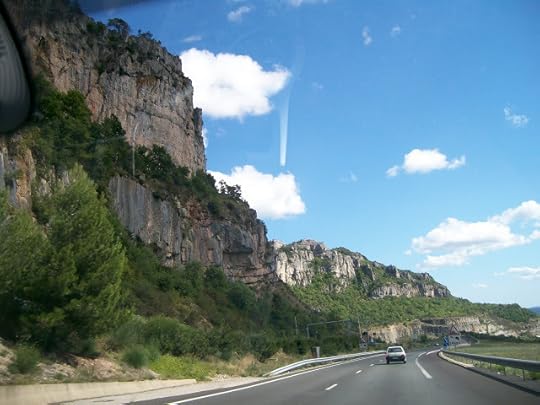 Pas de l'Escalette
Pas de l'Escalette
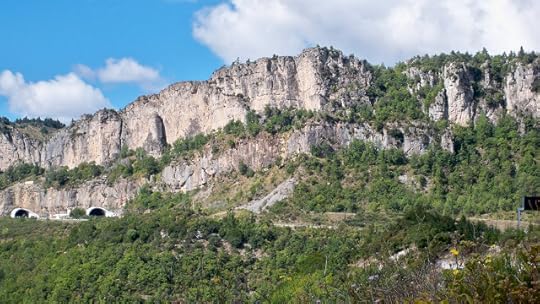 Pas de l'Escalette tunnels, no photo does this pass justice. It emerges onto the Larzac Causse, which leads to the Millau viaduct which is 750 metres high and leads to the upper gorges of the Tarn and Jonte.
Pas de l'Escalette tunnels, no photo does this pass justice. It emerges onto the Larzac Causse, which leads to the Millau viaduct which is 750 metres high and leads to the upper gorges of the Tarn and Jonte.

This August, B and I rented a house up the remotest hill of the Orb Valley for one week. The evening we arrived the snowy tree crickets' chirrs filled the house from every window, a sound much like moonlight if it had a voice, more otherworldly than the daytime cicadas, another sound I love. Ours was the last house of the hamlet of Le Lau and the surrounding woods are wild boar hunting grounds. One morning I heard the dogs and hunters capturing a boar; its shrieks gave me a migraine. At night I heard genets, which sound like a cross betweeen a cat and a fox. I saw one darting across the car park when we visited the Gorge de l'Hèric, spotted and with a long bushy tail. On our last night, we heard a boar snuffling and grunting just a few feet away from us as we sat on the unfenced terrace. It was enthralling to be so close but after standing closer to peer at him (he could have charged!) we decided to retreat to safety.
To get to the Gorge du Tarn, Gorge de la Jonte (and its vultures) and the Chaos of Montpellier le Vieux, B had to drive up the Pas de l'Escalette. This is a spectacular pass from the Languedocien plain to the Causses (limestone moors) of the most southerly Massif Central range. The A75 autoroute recently replaced the old A9 road, which we both remember, and that, in its time, replaced an iron ladder for passengers to disembark from their carriages, climb up the cliff, then continue in another carriage. Now, there is a series of tunnels that cuts through then winds round the Steps of the Ladder. It's only this time that I realised just how much this landscape paved the way for my obsession with Venezuela's Lost World, with its cliff-bordered sky-islands. The causses and gorges were the prototype, so that when I journeyed to the Lost World I recognised it as home, though it plainly wasn't, and is actually hostile in its remoteness and grandeur.
 View from the lane above Le Lau across the Orb Valley, early morning
View from the lane above Le Lau across the Orb Valley, early morning View from Chaos of Montpellier le Vieux
View from Chaos of Montpellier le Vieux Village of Trèves on the road to Gorge du Tarn
Village of Trèves on the road to Gorge du Tarn Gorge du Tarn
Gorge du Tarn The medieval and higgledy hamlet of Le Lau from the kitchen door
The medieval and higgledy hamlet of Le Lau from the kitchen door The sudden storm from the living-room window, thunder echoed around the hills and the wind was wild!
The sudden storm from the living-room window, thunder echoed around the hills and the wind was wild! The house from the lane to Le Lau
The house from the lane to Le Lau Chaos of Montpellier le Vieux on the Causse Noir
Chaos of Montpellier le Vieux on the Causse Noir Chaos of Montpellier le Vieux is just like the tops of Venezuela's plateaus, with eroded rock shapes, though these are limestone and those are quartzite sandstone.
Chaos of Montpellier le Vieux is just like the tops of Venezuela's plateaus, with eroded rock shapes, though these are limestone and those are quartzite sandstone. A typical panorama
A typical panorama Vineyards in the Orb Valley, on our way to the Forest of War Veteran Writers
Vineyards in the Orb Valley, on our way to the Forest of War Veteran Writers Pas de l'Escalette
Pas de l'Escalette Pas de l'Escalette tunnels, no photo does this pass justice. It emerges onto the Larzac Causse, which leads to the Millau viaduct which is 750 metres high and leads to the upper gorges of the Tarn and Jonte.
Pas de l'Escalette tunnels, no photo does this pass justice. It emerges onto the Larzac Causse, which leads to the Millau viaduct which is 750 metres high and leads to the upper gorges of the Tarn and Jonte.
Published on August 23, 2011 08:48



